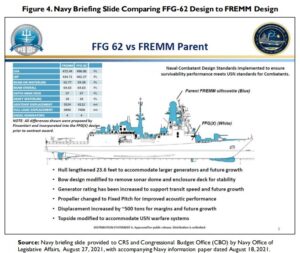A new report from the Congressional Research Service (CRS) outlines the changes made to the new Constellation-class (FFG-62) frigate from its parent design.
The Navy awarded Fincantieri’s Marinette Marine a $795 million contract in 2020 for the detail design and construction of the first frigate, with options for the following nine ships. The Navy plans to procure upward of 20 total (Defense Daily, April 30, 2020).
The original frigate competition required contractors to use parent designs to speed up the process of production and delivery. Fincantieri offered up a version of the Italian and French FREMM multipurpose frigate. This CRS report, updated Sept. 15, underscored the parent design approach aimed to reduce design time, design cost, total cost, schedule, and technical risk.
CRS, using information provided by the Navy, summarized the primary differences between the FFG-62 and FREMM.

The differences include a total hull length 23.6 feet larger “to accommodate larger generators and future growth,” 500 tons greater total load displacement “for margins and future growth,” bow design modified to reduce the sonar dome and enclosure deck for stability, increased generator rating to support transit speed and future growth, propeller changed the fixed pitch for “improved acoustic performance,” and topside modified to accommodate U.S. Navy warfare systems.
In August, Capt. Kevin Smith, program manager of the new frigate class, PMS-515, said while no decision has been made yet, since the contract includes a Technical Data package the Navy can exercise it and work with other yards to potentially build a second contractor source to produce more frigates at a faster rate (Defense Daily, Aug. 3).
At the time Smith also noted Fincantieri and its partner, Leidos’ Gibbs & Cox [LDOS], were working on functional design and detail design. That extra design is due to Fincantieri and the Navy increasing the ship size along with other minor changes.
“The actual design is much like the parent design. The Italians did a very good job at the design of the internal spaces and the flow of a lot of the spaces. So we’ve adopted all of that. I guess you can say we bought a bigger house and from a modeling and simulation perspective, it’s exactly the same. So it’s more, just guess you would say, scale,” Smith added.
At the time, Smith did not clarify when the design changes occurred.
However, the recent CRS report said the Navy noted the design differences were proposed by Fincantieri and incorporated into its original proposed design before the contract award. Therefore, the changes Smith outlined were baked into the original competition.